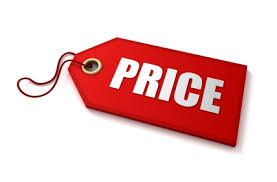Have you ever wondered why you buy what you buy? You can spend your money on anything you want, but what is it that makes you decide to buy one thing over another?
If you can understand what makes your customers buy you’ll be able to increase the effectiveness of your marketing and sell more goods. You’ll also be able to understand your own buying behaviours and habits.
So what is the mysterious force that makes us buy? Well, the answer is quite simple – it’s motivation.
Motivation is the driving force behind all human behaviour and action
This also applies to purchase behaviour. But what creates motivation? The answer is goals! Goals create the motivation that makes us take action and buy things.
The goal value
A goal value is how relevant a product or service is to fulfilling our active goals. We attribute a higher “goal value” to products that satisfy our active goals, and a lower “goal value” to those that don’t.
Example:
If we are hungry, we have the goal of eating and feeling full. Food items become more rewarding to us or have an increased “goal value”, therefore our willingness to pay for food increases. When we are not hungry we don’t have the goal of eating, therefore we are less willing to pay for food items. That makes sense, right?
The more relevant a product or service is for an active goal, the higher the expected reward, and the more motivated we are to pay for it. If you feel really hungry and drive past a restaurant or Burger King drive-thru, the goal of buying food to satisfy your hunger becomes more appealing and your willingness to pay for that rewarding feeling is high.
But after you’ve just eaten and satisfied your hunger you can drive past the next 10 Burger King’s and not even look at them. Your willingness to stop and purchase some food is diminished because you no longer have the active goal of eliminating your hunger, therefore food has a low goal value at that moment.
If products or services fit into your active goals they offer a high goal value and you are more willing to pay for them. Our goals, therefore, determine how we decide what to spend our money on.
We have different active goals for each situation. Our active goals for buying laundry detergent are different from our active goals for buying an automobile.
Example:
Let’s say we are out looking for a new car. Price difference aside, how do we decide between the Mustang or Volvo? It depends on what our overall goal is.
If our goal is to buy a family car, then safety is an important element. In that case, we are more likely to go for the Volvo because the brand is well associated with safety, and therefore has a higher goal value in this instance. If our goal for buying a car is to look flashy, or we have a need for speed, then we are more likely to buy the Mustang as it has an overall higher goal value in this context.
When comparing two competing brands or products that are equally priced, we will normally go for the one with the highest overall goal value. We are motivated to achieve goals that are of high value to us.
What does this mean to us as marketers?
We can take some valuable marketing lessons and insights from this understanding of how goals affect purchase behaviour.
1. Create products or services that fulfill your prospect’s goals
If we understand what goals our prospects want to achieve, we can create goods or services that fulfill their goals, and ultimately sell more products. Pretty straightforward, right? Give the people what they want.
That’s why it is so important to understand your target market. When you know what your target audience’s goals are, and then create products and services that help them achieve those goals, you will be more successful. What problems do they have? What are they trying to achieve? What do they want more of or less of?
When you drill down into these questions you will gain a better understanding of your prospects and the goals which motivate them to buy. When you know what their goals are, you can design, create, or produce goods or services that meet help them achieve their goals.
2. Your prospect’s goals will determine how your product is perceived
Let’s say you sell cupcakes outside a block of busy offices. If your prospect’s goal is to alleviate their hunger before lunch with a sweet treat then you’re in luck because a cupcake fulfills this goal and will have a high goal value in this context. Your prospect, therefore, perceives the cupcake as a great purchase and reaches for their wallet.
But what if your prospect’s goal is to alleviate their hunger before lunch with a healthy, low sugary snack that won’t ruin their appetite? A cupcake will have a low goal value in this context and your prospect will most likely purchase an apple instead. Same product, same customer, but the difference in goal alters the perception of your product.
Different segments of your customers will have different goals. As we’ve seen in the example above, the same customer will also often have different goals depending on their situation. What can you do to address this?
As marketers, you should design different campaigns for each of your prospect’s goals.
Let’s say you own a coffee house. Some people like to go to a coffee house and have a relaxing cup of joe before they head to the office – so to target customers who have this goal your adverts should emphasise the warm environment, chilled music, and comfy chairs in your coffee house Other customers like to grab a coffee and drink it on their way to work or when they get to the office – so create an ad that focuses on your quick takeaway service and the fact your coffee tastes great no matter how it’s served or consumed.
When you create different campaigns for each goal you’ll start to see an improvement in your ad performance.
3. Goals drive attention
Our goals determine where we place our attention.
Let’s do an experiment. You have 30 seconds to identify and count every red object you can see around you right now. Ready? Go! OK, how many blue items did you count? I’m going to guess probably zero. Why is this? Because your attention was focused on looking for red items.
Your Reticular Activating System (RSA) is the part of your brain that filters the world based on your goals. If your goal is to find red items, your RSA filters out anything else which isn’t red so you can focus your attention on finding those that are. The non-blue items don’t suddenly disappear, it’s just that you’re not actively looking for them and so they are filtered out from your conscious perception.
As marketers, this means that your ads will be viewed differently depending on what your customer’s goals are. They will place their attention on different parts of your ad, features, or benefits depending on what they are trying to achieve through the use of your product or service.
If someone wants to buy a family car the goal of safety will be one of their priorities. They will therefore pay more attention to anything in your ad that mentions the safety aspects of the car – child locks, better braking system, rear passenger airbags, external cameras, etc.
When you know what your prospect’s goals are you can create ads or marketing campaigns that draw their attention to certain features, benefits, or USPs that meet those goals. Your ads will therefore be highly targeted and appear more relevant to your prospects. High relevance will increase the perception of your product’s ability to fulfill the desired goal, increasing its goal value and making them more likely to buy.
Summary and concluding thoughts
We buy products or services that we think will fulfill our active goals. We give these products or services a higher goal value. The higher the goal value of a product or service in a specific context, the more willing we are to buy it.
Start thinking about your product or service in terms of the goal or goals it fulfills. When you understand what result or reward your prospects are seeking from your product, you can design different advertising strategies and campaigns to highlight its ability to do so.
Different customers will have different active goals for the same product or service, your job as a marketer is to make sure you communicate with each of these customers differently by focusing on how your product or service fulfills each goal.
When you start thinking of your target market in terms of the different goals they have, you will have a wider and more targeted segmentation strategy which will boost the effectiveness of your advertising.




